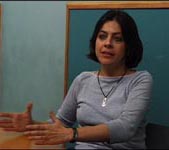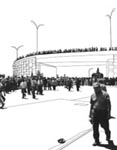| CARACAS, HECHO EN VENEZUELA Sabine Bitter, Helmut Weber |
||||
| CONCEPT, August 03 |
<< |
|||
   |
||||
|
How is Caracas made?
Current discussions in architecture and urbanism continue to consider individual use, guides to consumption, and the appropriation of space as the limits of what is possible in urban territories. Yet, appropriation and consumption do not imply a transformation of social and spatial relations. Since being in Caracas we have noticed forms of urbanism that are a part of a greater social transformation and not merely the appropriation of space within existing social relations. This is a transformative urbanism that is both spatial and social. Formal and informal practices cut through all of the city – formal practices are not only the right of the powerful and informal practices are not merely the cultural domain of the weak. In Caracas, the struggle for new spatial relations is interlaced into a transformation of the formal and informal. Spatial programs like urban and rural land reform, land titles and urban agriculture are tied into and related with healthcare and educational programs. These programs are not solely administrated and executed from above by governmental structures -- although they link to these structures -- but are forcefully initiated from below by collective community organizations. Collective everday practices produce the new spatial relations of Caracas, and in a larger sense, they produce Caracas. Following Henri Lefebvre’s concept of the ‘production of space’, in CARACAS, HECHO EN VENEZUELA, we emphasize the processes of the ‘production of the city.’ What are the specific sites and modes of production of contemporary Caracas? We examine three entry points for the production of Caracas: modernist urban planning and architecture; participatory democracy; and the dominant economic force, the Venezuelan oil industry. To represent these forces, we have chosen 23 de Enero as an example of contested modernist urban planning and architecture and as a site of political struggle – for example, through the mass squatting of 1958. We use the new Constitution of the Bolivarian Republic of Venezuela as a state structure which has been appropriated for participatory democracy. Lastly, we take Venezuela’s national oil company, PDVSA, as an economic force which has inscribed Venzuela into the global economic system and as a site of national political and economic struggle which shapes the city. By engaging with these productive forces and tensions of the city, with CARACAS, HECHO EN VENEZUELA we address the urban/national and urban/global connections and the spatial relations of class relevant to the city and its people. |
||||
| 23 de Enero/Constitution, Print To link two productive processes of Caracas -- 23 de Enero and the new Constitution -- we altered an aerial image of 23 de Enero with software we developed. Through this process, the aerial image of 23 de Enero is reconstructed with text characters and the entire Constitution of the Bolivarian Republic of Venezuela. The aerial photograph mimics the scopic regime of a modernism which sought to rationalize spatial relations, yet the Constitution of the Bolivarian Republic of Venzuela aims at an opposing view which tries to build a participatory democracy from the streets up. 23 de Enero represents the trransformation from modernist rationality to an insurgent urbanism – an insurgency made through the politics of its inhabitants. This work is shown in the Bellas Artes Metro Station, in the Nichos Culturales with the kind support of the Metro De Caracas. |
||||
| 23 de Enero/Constitution, Video In the video, Caraqueños are interviewed about the everyday use of two megastructures – the new Constitution of the Bolivarian Republic of Venezuela and the insurgent and informal urbanism of the historically and politically central 23 de Enero. The answers of the architects, social activists, governmental experts, artists and people who live in 23 de Enero who are interviewed examine the relationship between these two productive forces which shape Caracas. The problematic of appropriation is overturned – the limits of appropriation are challenged by new spatial and social relations that smash the program of the oppressive local modernism and open up to greater social participation. |
||||
| Marches City Centre, Drawings This series of photographs of demonstrations and marches in Caracas have been digitally altered – the architecture and the cityscape have been sketched out, rendering it more as an ideal or even utopian architectural drawing which recalls the optimistic aesthetics of the collage works from late-60s architectural groups such as Archigram and Superstudio. The language of this moment of utopian architecture with terms such as ‘total urbanization’ and ‘absolute egalitarianism’ is replaced in our sketches with the forceful language of protest and change: ‘The Workers are the Builders of the Country,’ ‘Workers in the Process of Change.’ ‘Bolivarian Workers at the Front of the Revolution.’ By abstracting the architecture, it is reduced from the main texture and structure of the urban territitory, and the citizens – with their signs and banners – are made more vital and central. Representing a transformative urbanism that is both spatial and social, their collective mobilization moves through the urban space, producing the city. Printed in an newsprint edition of 2000 by the Instituto Municipal de Publicaciones, Alcaldia de Caracas. |
||||
| Team: Osvaldo Michelli and Katharina Rhode Video support by: Nicolas Bancilhon, M. Alejandra Padron, Victor Sanchez Thanks to: METRO de Caracas, the helicoptercrew from FM, Coordinadora Simon Bolivar and the people from 23 de Enero, Raul Zelik, Jeff Derksen, Andreina Belfort, the people in the video and all those who introduced us to Caracas. |
||||